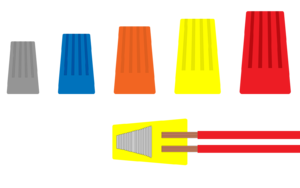Difference between revisions of "Twist-on wire connector"
Jump to navigation
Jump to search
m (Alex moved page Twist on wire connector to Twist-on wire connector without leaving a redirect) |
(Marked this version for translation) |
||
| (3 intermediate revisions by the same user not shown) | |||
| Line 1: | Line 1: | ||
[[Category:Power distribution]] | [[Category:Power distribution]] | ||
| + | <languages /> | ||
| + | <translate> | ||
| + | <!--T:1--> | ||
[[File:Twistonwireconnectors210101.png|thumb|''Above -''Twist-on wire connectors by size and color.<br />''Below -'' Cross-section of a connector with wires entering.]] | [[File:Twistonwireconnectors210101.png|thumb|''Above -''Twist-on wire connectors by size and color.<br />''Below -'' Cross-section of a connector with wires entering.]] | ||
| − | |||
| − | ===Considerations=== | + | <!--T:2--> |
| − | *Twist on connectors should always be located inside of a [[Junction box|junction box]] or another type of enclosure to ensure that they are protected against damage or unauthorized access. | + | Twist-on wire connectors are commonly available and cheap way to make connections in circuits. They come in various sizes that are color coded but are only typically used for smaller circuits with wires that are 6 mm² (10 AWG) and smaller. They consist of a plastic body with a threaded spring inside. Two or more wires - solid or stranded - can be inserted into the connector and then it can be twisted, it will tighten around the wires and create a solid connection. |
| + | |||
| + | ===Considerations=== <!--T:3--> | ||
| + | |||
| + | <!--T:4--> | ||
| + | *Twist on connectors should always be located inside of a [[Special:MyLanguage/Junction box|junction box]] or another type of enclosure to ensure that they are protected against damage or unauthorized access. | ||
*The wires entering a twist-on connector should always be tugged on after installation to make verify that the connection is solid and will not come loose later on. | *The wires entering a twist-on connector should always be tugged on after installation to make verify that the connection is solid and will not come loose later on. | ||
| − | *The appropriate size connector must be used for the wires that are being connected. Larger wire nuts can accept multiple smaller wires | + | *The appropriate size connector must be used for the wires that are being connected. Larger wire nuts can accept multiple smaller wires. |
| + | <!--T:5--> | ||
{| border="2" align="center" class="wikitable" | {| border="2" align="center" class="wikitable" | ||
! rowspan=3|Color | ! rowspan=3|Color | ||
| Line 74: | Line 82: | ||
|} | |} | ||
| − | ==Notes/references== | + | ==Notes/references== <!--T:6--> |
<references/> | <references/> | ||
| + | </translate> | ||
Latest revision as of 13:44, 12 February 2021
Twist-on wire connectors are commonly available and cheap way to make connections in circuits. They come in various sizes that are color coded but are only typically used for smaller circuits with wires that are 6 mm² (10 AWG) and smaller. They consist of a plastic body with a threaded spring inside. Two or more wires - solid or stranded - can be inserted into the connector and then it can be twisted, it will tighten around the wires and create a solid connection.
Considerations
- Twist on connectors should always be located inside of a junction box or another type of enclosure to ensure that they are protected against damage or unauthorized access.
- The wires entering a twist-on connector should always be tugged on after installation to make verify that the connection is solid and will not come loose later on.
- The appropriate size connector must be used for the wires that are being connected. Larger wire nuts can accept multiple smaller wires.
| Color | Wire size[1] | ||||||
|---|---|---|---|---|---|---|---|
| 22 AWG (0.326 mm²) |
20 AWG (0.581 mm²) |
18 AWG (0.823 mm²) |
16 AWG (1.31 mm²) |
14 AWG (2.08 mm²) |
12 AWG (3.31 mm²) |
10 AWG (5.26 mm²) | |
| 0.5 mm² | 0.75 mm² | 1 mm² | 1.5 mm² | 2.5 mm² | 4 mm² | 6 mm² | |
| Gray | |||||||
| Blue | |||||||
| Orange | |||||||
| Yellow | |||||||
| Red | |||||||
